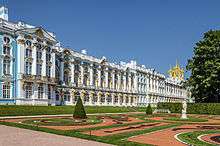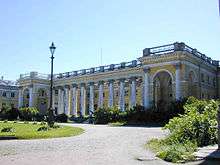Tsarskoye Selo
Coordinates: 59°43′24″N 30°24′57″E / 59.72333°N 30.41583°E

Tsarskoye Selo (Russian: Ца́рское Село́; IPA: [ˈtsarskəɪ sʲɪˈlo]; "Tsar's Village") was the town containing a former Russian residence of the imperial family and visiting nobility, located 24 kilometers (15 mi) south from the center of Saint Petersburg.[1] It is now part of the town of Pushkin. Tsarskoye Selo forms one of the World Heritage Site Saint Petersburg and Related Groups of Monuments. During the Soviet times it was known as Detskoye Selo.
History
In the 17th century, the estate belonged to a Swedish noble. Its original Finnish name is usually translated as "a higher ground". Max Vasmer, on the other hand, derives this toponym from the Finnish word for island, "saari": "Saaren kylä" = "Island village". In any case, the Finnish name came to be pronounced by the 18th-century Russians as "Sarskoye Selo", later changed to "Tsarskoye Selo" (i.e., "the royal village").
In 1708, Peter the Great gave the estate to his wife, the future Empress Catherine I, as a present. She founded the Blagoveschensky (Annunciation) church there in 1724, and changed the name of the settlement to Blagoveschenskoye, but this did not stand the test of time and quickly went out of use.
It was Catherine I who started to develop the place as a royal country residence. Her daughter, Empress Elizabeth and her architect Bartolomeo Rastrelli were largely responsible for the building of the Catherine Palace. Later Empress Catherine II of Russia and her architect Charles Cameron extended the palace building that is now known as the Cameron Gallery. Currently, there are two imperial palaces: the baroque Catherine Palace with the adjacent Catherine Park and the neoclassical Alexander Palace with the adjacent Alexander Park. The Catherine Palace is surrounded by a Garden à la française and an English landscape garden, with such 18th-century structures as Dutch Admiralty, Creaking Pagoda, Chesme Column, Rumyantsev Obelisk and Marble Bridge. The landscape Alexander Park has several Chinoiserie structures, notably the Chinese Village.

By the end of the 18th century, Tsarskoye Selo became a popular place of summer residence among the nobility. The guards' regiments were stationed to the south of Tsarskoye Selo, where Catherine the Great founded in the 1770s the town of Sophia (her own German name being Sophie). The five-domed neoclassical Ascension Cathedral, designed by Cameron, is the chief monument of that area.
The Royal Forestry School, perhaps the first such school in Russia, was founded in Tsarskoye Selo in 1803; it was moved to Saint Petersburg in 1811, to become the Imperial Forestry Institute.[2] In 1808, Sophia and Tsarskoye Selo merged and became one town.
.jpg)
In 1811, Alexander I opened the celebrated Lyceum next door to the Catherine Palace. Among the first students of the Lyceum who graduated in 1817 were Aleksandr Pushkin and Alexander Gorchakov. Mikhail Saltykov-Shchedrin also graduated from the Lyceum. The Lyceum garden, the house of the Lycee Director, the house of Ludwig-Wilhelm Tepper de Ferguson, Lyceum music teacher belong to important historic sites associated with the Lyceum of Pushkin's time.
The literary traditions of Tsarskoye Selo were continued in the 20th century by such notable poets as Anna Akhmatova and Innokenty Annensky.
The town escaped the 19th century industrialization, although it was between Tsarskoye Selo and St. Petersburg that the first Russian railway was built in 1837, Tsarskoye Selo Railway. It was also known for its powerful government radio station that was set up here in 1917. In the spring of 1917, Emperor Nicholas II was held under arrest in his favourite residence, the Alexander Palace.
In 1918, Tsarskoye Selo (Tsar's Village) was renamed by the Bolsheviks into Detskoye Selo (Children's Village) and in 1937 it was renamed again to the town of Pushkin, thus commemorating the centenary of the poet's death.
On September 17, 1941, the Germans occupied the town of Pushkin, destroying and plundering many historical monuments, buildings and other cultural artifacts, including the famous Amber Room. The Red Army liberated the town on January 24, 1944. After the war, reconstruction began on Tsarskoye Selo; many rooms in the Catherine Palace have been restored, but much work on the palatial church and the Alexander Palace is still under way.

See also
References
- ↑ Jabado, Salwa; Fodor's (2008). Fodor's Moscow and St. Petersburg. New York: Random House. p. 292. ISBN 1-4000-0717-8.
- ↑ St. Petersburg Encyclopedia. Accessed: May 6, 2012.
Further reading
- King, Greg (2006). The Court of the Last Tsar (hardback). Hoboken: John Wiley & Sons. ISBN 978-0-471-72763-7.
External links
| Wikimedia Commons has media related to Tsarskoye Selo. |
- Tsarskoye Selo, Pushkin town, historical facts of the city, map, local weather, directions from St. Petersburg
- The State Museum of Tsarskoye Selo
- Alexander Palace Time Machine The Alexander Palace Time Machine
- Tsarskoye Selo in 1910 – a guide to the Palaces, Park and Town
- Photo Tours of Tsarskoe Selo
- Last Days at Tsarskoe Selo Last Days at Tsarskoe Selo by Count Paul Beckendorff
- Photographic views of Tsarskoye Selo, c. 2002 The Nostalgic Glass
- Tsarskoye Selo Photos Iconicarchive Gallery
- Bernard DeCou's colored photos of Tsarskoye Selo, c. 1931